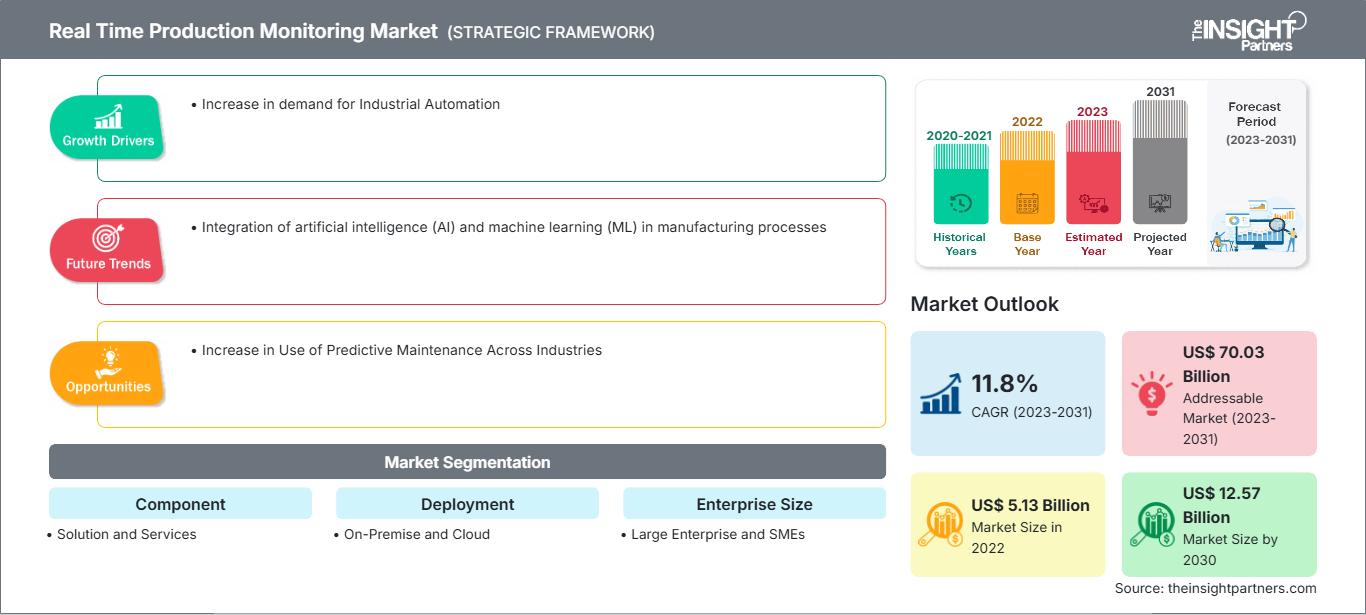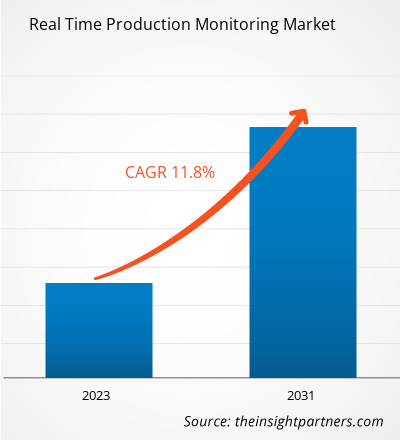실시간 생산 모니터링 시장 규모는 2022년 51억 3천만 달러에서 2030년에는 125억 7천만 달러에 이를 것으로 예상됩니다. 2022년부터 2030년까지 연평균 성장률(CAGR) 11.8%를 기록할 것으로 예상됩니다. 제조 공정에 인공지능(AI)과 머신러닝(ML)을 통합하는 것은 시장의 주요 트렌드로 남을 것으로 보입니다.
실시간 생산 모니터링 시장 분석
디지털 제조에 대한 수요 증가로 인해 시장은 꾸준히 성장해 왔습니다. 제조 부문의 디지털화는 제조업체가 생산 공정을 효율적으로 관리하는 데 도움이 되는 여러 기술을 도입하도록 이끌고 있습니다.
실시간 생산 모니터링 시장 개요
실시간 생산 모니터링은 생산 공정을 모니터링하는 데 도움이 되는 솔루션입니다. 생산 성과에 대한 모든 정보를 실시간으로 기록합니다. 모니터링 시스템은 제조업체 또는 생산 라인 운영자를 위해 여러 생산 라인 소스에서 생산 데이터를 수집합니다. 수집된 데이터는 효율적인 생산 워크플로우에 필요한 단계에 대한 통찰력을 확보하여 생산 라인 효율성을 개선하는 데 활용됩니다. 자동차, 화학, 석유 및 가스, 기계, 식음료 등 다양한 산업 분야에서 실시간 생산 모니터링 시장의 이러한 솔루션을 도입하는 제조업체들이 많습니다.
이 보고서의 일부, 국가 수준 분석, Excel 데이터 팩을 포함하여 모든 보고서에 대한 사용자 정의를 무료로 받을 수 있을 뿐만 아니라 스타트업 및 대학을 위한 훌륭한 제안 및 할인을 이용할 수 있습니다
실시간 생산 모니터링 시장: 전략적 통찰력

-
이 보고서의 주요 주요 시장 동향을 확인하세요.이 무료 샘플에는 시장 동향부터 추정 및 예측에 이르기까지 데이터 분석이 포함됩니다.
실시간 생산 모니터링 시장 성장 동력 및 기회
산업 자동화 수요 증가로 시장 활성화
산업 자동화는 로봇, 컴퓨터, 정보 기술과 같은 제어 시스템을 사용하여 산업 내 다양한 기계를 제어하고, 인간의 개입을 대체합니다. 관련 작업에 따라 산업 자동화 제어 시스템은 크게 공정 플랜트 자동화와 제조 자동화의 두 가지 유형으로 분류됩니다. 산업 자동화는 새롭고 혁신적이며 통합된 기술과 서비스를 도입하여 생산 및 설계 비용을 절감하는 동시에 높은 제품 품질, 신뢰성 및 생산 속도를 제공합니다. 높은 생산성, 품질, 유연성 및 정보 정확성과 같은 다양한 특징을 갖추고 있어 예측 기간 동안 산업 부문의 자동화 도입이 증가할 것으로 예상됩니다. 또한, 석유 및 가스, 제조, 화학 및 재료, 제약 및 기타 산업이 실시간 생산 모니터링 시장 성장을 견인하고 있습니다.
산업 전반의 예측 유지보수 사용 증가
디지털 기술의 발전으로 여러 제조 산업에서 예측 유지보수를 활용하고 있습니다. 이러한 스마트 산업은 제조 자산의 실시간 데이터를 활용하고 공장 현장의 센서가 수집하는 방대한 양의 빅데이터를 분석합니다. 이러한 분석을 위해서는 장비 가동 중단 시간을 줄이기 위한 예측 유지보수가 필요합니다. 실시간 생산 모니터링 시스템은 장비를 추적하고 알림을 전송하여 실제로 필수적인 작업만 수행되도록 합니다. 또한 이러한 시스템은 표준 컴퓨터 유지보수 관리 시스템(CMMS)과 유사한 예방 유지보수 기능을 갖춘 ERP(Enterprise Resource Planning) 시스템을 보완하는 모듈 형태로 제공되는 경우가 많습니다.
실시간 생산 모니터링 시장 보고서 세분화 분석
실시간 생산 모니터링 시장 분석 도출에 기여한 주요 세그먼트는 구성 요소, 배포, 기업 규모 및 산업입니다.
- 구성 요소를 기준으로 시장은 솔루션 및 서비스별로 세분화됩니다. 솔루션 부문은 2022년에 상당한 시장 점유율을 기록했습니다.
- 구축 방식을 기준으로 시장은 온프레미스와 클라우드로 구분됩니다. 클라우드 부문은 2022년에 더 큰 시장 점유율을 기록했습니다.
- 기업 규모를 기준으로 시장은 대기업과 중소기업으로 구분됩니다. 대기업 부문은 2022년에 더 큰 시장 점유율을 기록했습니다.
- 산업을 기준으로 시장은 공정 제조와 개별 제조로 구분됩니다. 공정 제조 부문은 2022년에 가장 큰 시장 점유율을 기록했습니다.
지역별 실시간 생산 모니터링 시장 점유율 분석
실시간 생산 모니터링 시장 보고서의 지리적 범위는 주로 북미, 아시아 태평양, 유럽, 중동 및 아프리카, 중남미의 5개 지역으로 나뉩니다.
아시아 태평양 지역은 2022년에 시장을 주도할 것으로 예상됩니다. 아시아 태평양 지역은 오랫동안 강력한 제조 기반을 제공해 왔으며, IoT를 적극적으로 도입하고 있습니다. IoT는 아시아 태평양 지역 전반의 다양한 산업 분야에 널리 도입되어 디지털 솔루션 도입으로 이어지고 있습니다. 아시아 태평양 지역은 제조 부문의 강점을 뒷받침할 강력한 잠재력을 보유하고 있습니다. 2023년 3월, Rockwell Automation Inc.는 제8회 연례 "스마트 제조 현황 보고서" 결과를 발표했습니다. 호주, 인도, 중국, 한국, 일본 등 1,350개 제조업체를 대상으로 실시한 설문조사에 따르면, 아시아 태평양 지역 제조업체의 약 44%가 향후 1년 내에 스마트 제조를 도입할 계획인 것으로 나타났습니다. 반면 중국 제조업체의 약 80%, 호주 제조업체의 60%, 인도 제조업체의 59%는 이미 스마트 제조의 일부 구성 요소를 사용하고 있는 것으로 나타났습니다. 따라서 스마트 제조 도입 증가와 기존 스마트 제조 시설의 증가는 아시아 태평양 지역의 강력한 실시간 생산 모니터링 시장 점유율을 보여주는데, 이 솔루션은 스마트 시설이 생산 워크플로우를 실시간으로 효율적으로 관리할 수 있도록 지원합니다.
실시간 생산 모니터링 시장 지역 통찰력
The Insight Partners의 분석가들은 예측 기간 동안 실시간 생산 모니터링 시장에 영향을 미치는 지역별 동향과 요인을 면밀히 설명했습니다. 이 섹션에서는 북미, 유럽, 아시아 태평양, 중동 및 아프리카, 그리고 중남미 지역의 실시간 생산 모니터링 시장 부문 및 지역별 현황도 살펴봅니다.
실시간 생산 모니터링 시장 보고서 범위
| 보고서 속성 | 세부 |
|---|---|
| 시장 규모 2022 | US$ 5.13 Billion |
| 시장규모별 2030 | US$ 12.57 Billion |
| 글로벌 CAGR (2023 - 2031) | 11.8% |
| 이전 데이터 | 2020-2021 |
| 예측 기간 | 2023-2031 |
| 다루는 세그먼트 |
By 구성 요소
|
| 포함된 지역 및 국가 |
북미
|
| 시장 선도 기업 및 주요 회사 프로필 |
|
실시간 생산 모니터링 시장 참여자 밀도: 비즈니스 역학에 미치는 영향 이해
실시간 생산 모니터링 시장은 소비자 선호도 변화, 기술 발전, 그리고 제품 이점에 대한 인식 제고 등의 요인으로 인한 최종 사용자 수요 증가에 힘입어 빠르게 성장하고 있습니다. 수요가 증가함에 따라 기업들은 제품 및 서비스를 확장하고, 소비자 니즈를 충족하기 위한 혁신을 추진하며, 새로운 트렌드를 적극 활용하고 있으며, 이는 시장 성장을 더욱 가속화하고 있습니다.

- 을 얻으세요 실시간 생산 모니터링 시장 주요 주요 플레이어 개요
실시간 생산 모니터링 시장 뉴스 및 최근 동향
실시간 생산 모니터링 시장은 1차 및 2차 조사 이후 주요 기업 간행물, 협회 데이터, 데이터베이스 등 정성적 및 정량적 데이터를 수집하여 평가합니다. 실시간 생산 모니터링 시장의 몇 가지 동향은 다음과 같습니다.
- 비즈니스 및 기술 혁신 서비스 분야의 글로벌 리더인 Capgemini와 에너지 관리 및 자동화 분야의 디지털 혁신을 선도하는 Schneider Electric®은 에너지 최적화를 위한 새로운 협업을 발표했습니다. 기업이 더욱 스마트하고 친환경적인 시설 관리 및 에너지 효율을 향한 여정을 가속화할 수 있도록 설계된 Energy Command Center는 디지털 솔루션과 최첨단 기술의 고유한 엔드 투 엔드 조합을 활용하여 에너지 관리를 간소화하고 소비를 최적화합니다. (출처: CAPGEMINI, 보도자료, 2024년 5월)
- Oracle은 Oracle Fusion Cloud Applications Suite에 새로운 생성적 AI 기능을 추가하여 고객의 의사 결정을 개선하고 직원 및 고객 경험을 향상하는 데 도움을 줄 것이라고 발표했습니다. 최신 AI 기능에는 재무, 공급망, HR, 영업, 마케팅, 서비스 등 기존 비즈니스 워크플로에 내장된 새로운 생성적 AI 기능과 Oracle Guided Journeys 확장성 프레임워크가 포함되어 고객과 파트너가 고유한 산업 및 경쟁 요구 사항을 충족하기 위해 더욱 생성적 AI 기능을 통합할 수 있도록 지원합니다. (출처: Oracle, 보도자료, 2022년 3월)
실시간 생산 모니터링 시장 보고서 범위 및 제공 내용
“실시간 생산 모니터링 시장 규모 및 예측(2020~2030)” 보고서는 다음 영역을 포괄하는 시장에 대한 자세한 분석을 제공합니다.
- 범위에 포함된 모든 주요 시장 세그먼트에 대한 글로벌, 지역 및 국가 수준의 실시간 생산 모니터링 시장 규모 및 예측
- 실시간 생산 모니터링 시장 동향 및 추진 요인, 제약 및 주요 기회와 같은 시장 역학
- 자세한 PEST/포터의 5가지 힘 및 SWOT 분석
- 주요 시장 동향, 글로벌 및 지역 프레임워크, 주요 업체, 규정 및 최근 시장 개발을 포괄하는 실시간 생산 모니터링 시장 분석
- 시장 집중도, 히트맵 분석, 주요 업체 및 실시간 생산 모니터링 시장의 최근 개발을 포괄하는 산업 환경 및 경쟁 분석
- 자세한 회사 프로필
- 과거 분석(2년), 기준 연도, CAGR을 포함한 예측(7년)
- PEST 및 SWOT 분석
- 시장 규모 가치/거래량 - 글로벌, 지역, 국가
- 산업 및 경쟁 환경
- Excel 데이터세트
최근 보고서
사용 후기
구매 이유
- 정보에 기반한 의사 결정
- 시장 역학 이해
- 경쟁 분석
- 고객 인사이트
- 시장 예측
- 위험 완화
- 전략 기획
- 투자 타당성 분석
- 신흥 시장 파악
- 마케팅 전략 강화
- 운영 효율성 향상
- 규제 동향에 발맞춰 대응






















 무료 샘플 받기 - 실시간 생산 모니터링 시장
무료 샘플 받기 - 실시간 생산 모니터링 시장